The Piriformis muscle
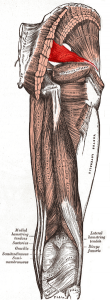 The piriformis muscle is categorized as one of six deep lateral rotators of the hip and is one of only three muscles that connect the legs to the spine.
The piriformis muscle is categorized as one of six deep lateral rotators of the hip and is one of only three muscles that connect the legs to the spine.
If you know of your piriformis muscle you probably consider it more of an irritant than a rotator.
Let’s look closely at the specific functions of this consternating muscle.
The piriformis muscle originates on the front portion of the sacrum, the triangular bone wedged between the two hip bones, passes under the greater sciatic notch (an opening of the pelvis) and attaches to the top of the greater trochanter, a bony prominence on the outside of the femur (thigh) bone.
The piriformis muscle is involved in a number of actions.
It assists in turning the foot out, drawing the leg away from the body when the leg is flexed, and extension of the hip joint.
Contraction of the piriformis muscle moves the body in different directions depending on which bones do what.
If the sacrum is stable the leg turns out but if the leg is fixed, movement will come through the pelvis.
It is an amazing thing when your think of how many muscles, bones, ligaments, and tendons are involved in every movement we make. Nothing happens in isolation.
Here is a way to feel the piriformis muscle at work.
Stand with your feet together, your knees bent and your butt stuck out a little.
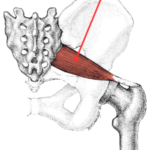
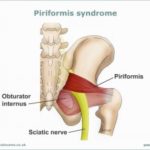
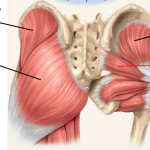
Put your hands on your butt and draw your knees apart slightly.
Your piriformis muscle should be working beneath your big gluteal muscles.
Another essential role of the piriformis muscle is the balance it seeks to create with the psoas major and gluteus maximus, the only other muscles that attach the legs to the spine.
The piriformis muscle is the only one of these deep hip muscles that attach to the front portion of the sacrum.
This brings it across the sacroiliac joint and its pull on the sacrum at the back body works with/against the psoas’ major pull at the front to bring balance to our delicate upright posture.
Imagine the psoas major pulling forward and down on the lumbar vertebrae at the front and the piriformis muscle drawing the sacrum down at the back.
This interplay with the psoas major is one of the most important of the body’s balancing acts, and as I will explain below, almost everyone is losing out on an extraordinary ability to find ease within our body.
One of our key postural issues regarding the piriformis muscle is the position of our legs below the pelvis.
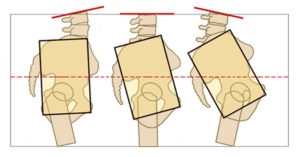
The length and tone of the hip muscles are determined by the ease of the femur bones connected to the hip.
If the head of the femur is free in the hip socket (acetabulum) the leg will fall to the ground with the ankle joint aligning with the middle of the kneecap and the center of the hip joint.
If you are standing as we are designed, the feet are close to parallel and barely apart and these deep hip muscles will be in their ideal resting position.
It is not that they are engaging; they were designed to be this length in standing.
If we stand and walk with our feet always turned out, the length and tone of the hip muscles will change.
They will always live in a lax or short state as they are not naturally drawn to their proper length.
This is easy to see in people as the displacement of the leg in the hip socket always manifests in the eventual turn out of the foot.
Anyone who walks around with their feet splayed has strange things going on in their hip muscles.
For the piriformis muscle this means that if the leg is turned open, or the thighs are pulled forward, it will have no contractile strength and will not be exerting its pull on the sacrum at the back to balance the opposite pull of the psoas major at the front.
Obviously, if this is the posture that we always inhabit our piriformis muscle is always lax or short.
You can get away with this for a long time or even a lifetime if you are lucky.
But if you know about the pain that can arise from problems with the piriformis muscle there is a lot of incentive to learn about and understand this muscle. It is not difficult to make a few easy changes to your posture and bring your piriformis muscle around to being a team player in the complex of the pelvis.
***
